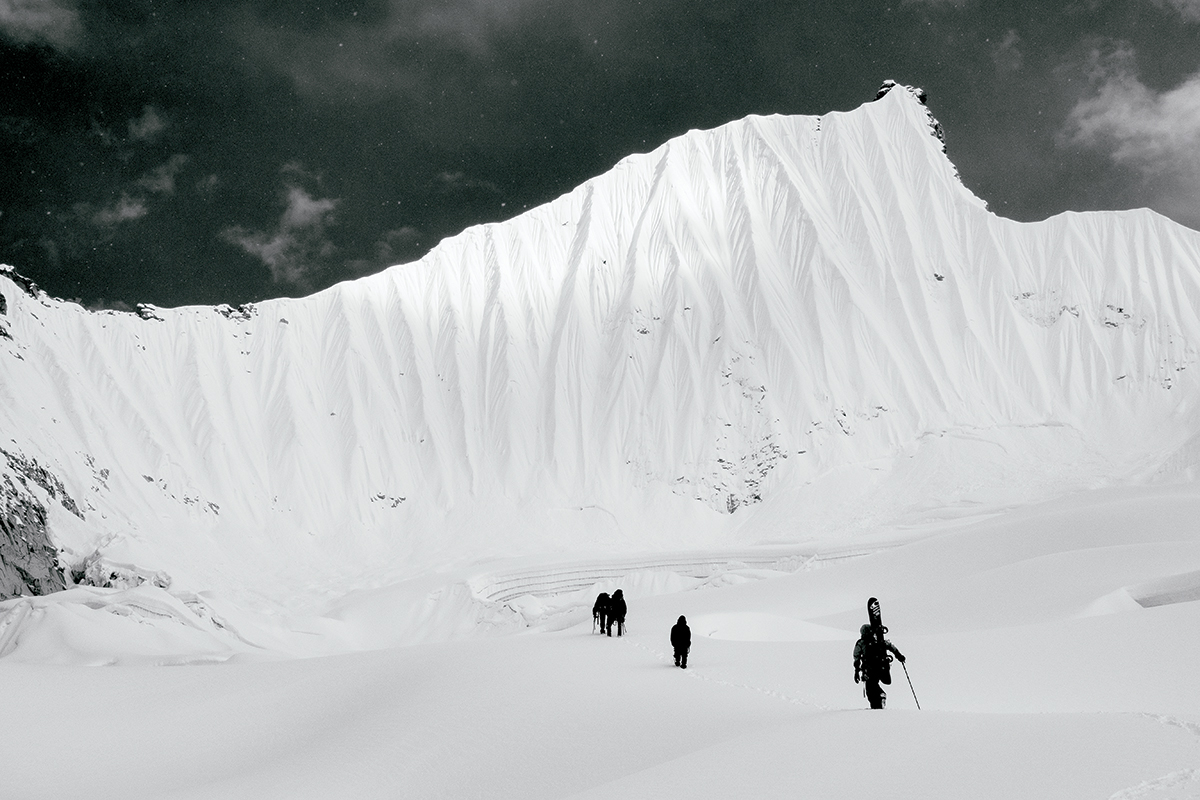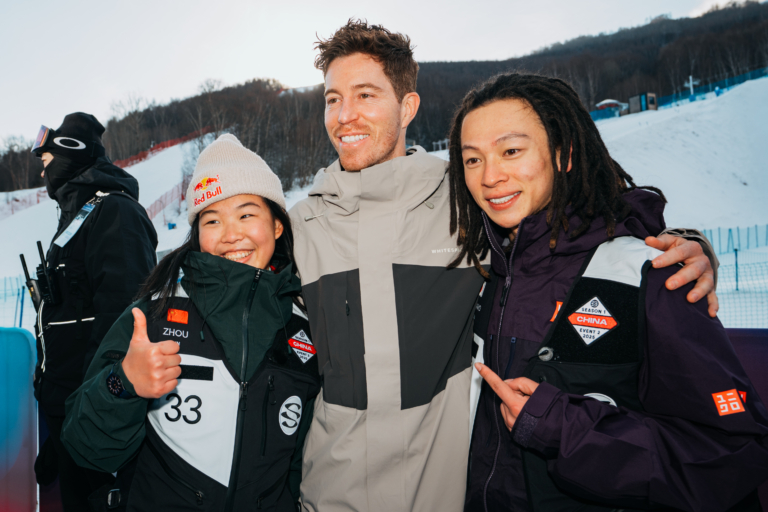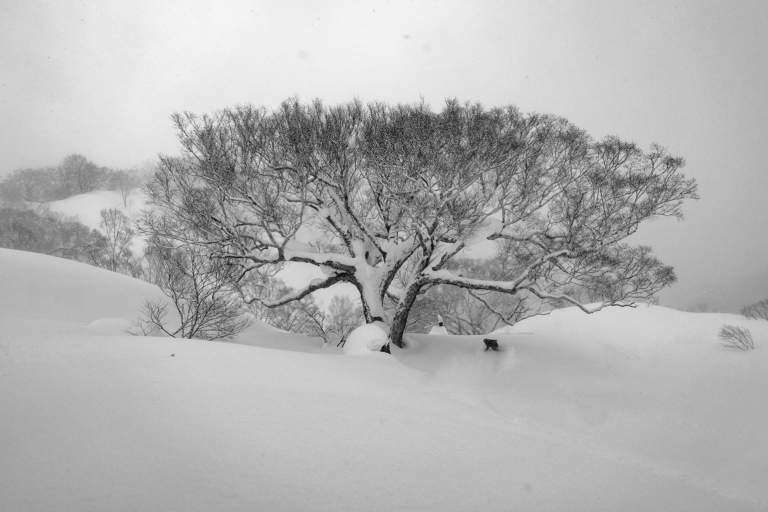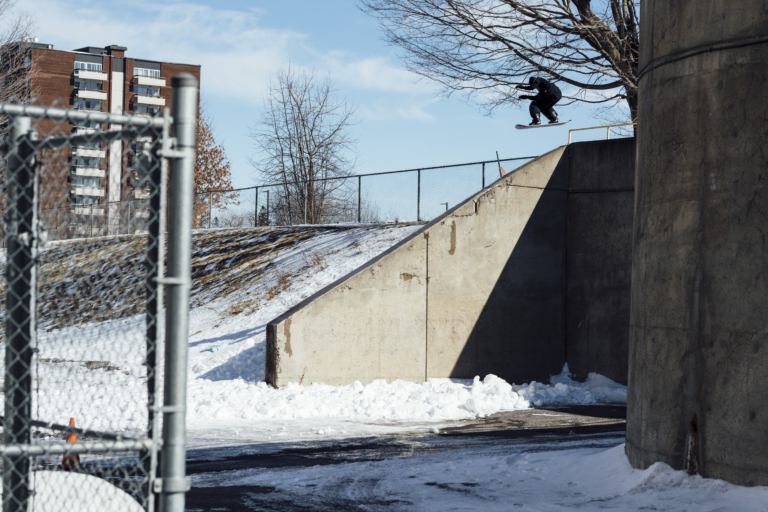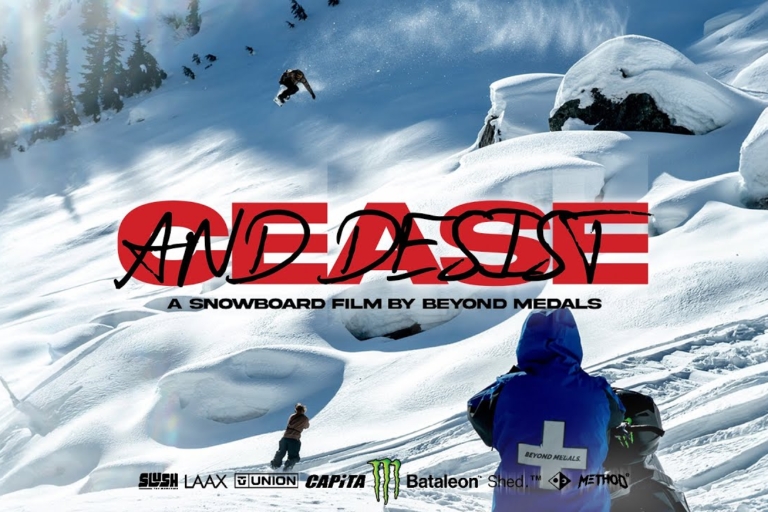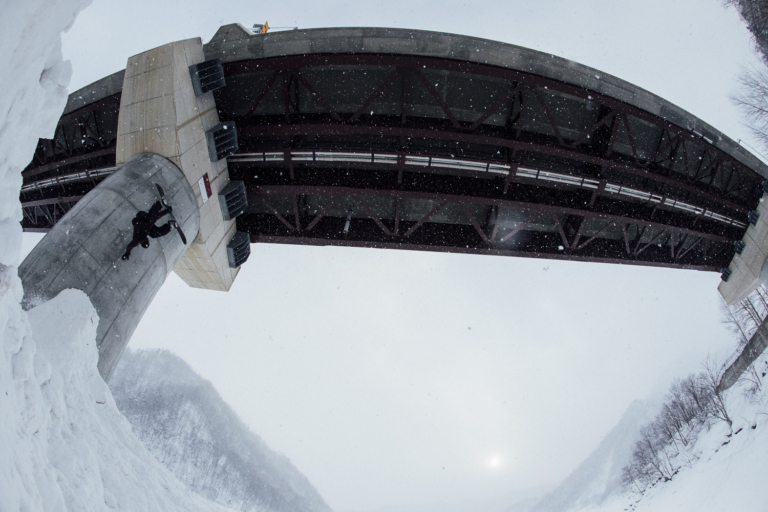To achieve the level of snowboarding Jeremy Jones has crafted, one needs an unusual amount of dedication. And we’re not talking simple training to be the best. His commitment is much more personal, hence the unique nature of his evolution. In a scene rife with copycats and showoffs, the big mountain legend wages his dreams in pursuit of personal fulfillment, not egotistic exploits. His aspirations, while lofty, are towards inner experience, not bragging rights. Talking with him, it soon becomes apparent that he’s kind of got it figured out. In fact, he seems remarkably stable for someone whose documented history would suggest a heroic intake of heavy medication.
Reflecting on the culminating episode of his epic three-part saga, Jones spoke to us not so much about how he does what he does or the details of high adventures, but rather why he does these things. Exploring childhood issues, traumatizing events with a Viking and mind-altering experiences with allegorical giants, Jones takes us Deeper, Further, Higher and finally, into the unmapped areas of conscious expansion.
“You ask me how to make these movies?” he asks deliberately. “You go all in.”
[aesop_gallery id=”58907″]
I guess we should start at the beginning, right?
I grew up on Cape Cod with a huge extended family. I’d say 95 percent still live there with the other 5 percent still nearby on the East Coast. Now, I only bring that up to show that very few people leave there. However, my grandfather used to go up to Vermont and in turn my parents used to go and naturally they took us kids up there, me and my two older brothers. I just remember how blown away I was at this other world that existed. This was before snowboarding even. I was like, “I’m living in the mountains, this is the coolest place in the world!”
So was your dream always to become a pro snowboarder or did you just know you wanted to live in the mountains when you were a kid?
For sure, my first goal was to become a pro snowboarder and I put everything I had into that to the point beyond anything I would recommend in the sense that I blew off school, I barely graduated and had no backup plan. I went all in. And it worked out, but again, if it didn’t work out I knew I would just find another job that allowed me to snowboard, whether it was a mountain guide, a camera man, a ski instructor, I didn’t care! Goal one: be a pro snowboarder. Goal two? I’ll figure that out if I don’t make it.
In that sense, it’s bound to work out because there’s no other option. Or at least the other option isn’t back home wishing you had taken the leap.
These mountain towns are filled with that kind of mentality, where a lot of people want to be pro snowboarders, but then they realize that sometimes that’s just not attainable so they figure out a different way to ride. My snowboarding now, unless I’m on one of these big trips, I snowboard with locals. These are guys that have set up their lives in a way so that they can ride every day, all day. And these are the guys who are charging more so than a lot of the pros.
[aesop_quote type=”block” align=”left” quote=”“MY SNOWBOARDING NOW, UNLESS I’M ON ONE OF THESE BIG TRIPS, I SNOWBOARD WITH LOCALS.””]
I go out with these older guys like Jim Zellers and Tom Burt who still destroy me. I know that if I head out with them I need to have my skins on the night before and be ready — full power. And at the resorts I’m out there with the guys in their early to mid-twenties because they are still amped to go ride on a rainy Tuesday, which I still really enjoy.
So your snowboarding isn’t all crampons and twenty-mile approaches?
My snowboarding is definitely not always that. I’m at a point where snowboarding is so many different things. Splitboarding has made me appreciate the resorts more than ever. I’m rejuvenated out there when I don’t have to wear a pack and get to ride a small board. Also, my kids are getting to an age now where I go out with them a bunch. And then I go powder surfing right here in my backyard. Then there is a ton of mellow touring. I’ve become much less picky these days. It’s clear these past two winters in the Sierra with how bad the snow has been that I don’t need a lot of pow and perfectly sunny days to have a lot of fun. Snowboarders that need to have perfect pow to have a good day? What a miserable existence! [Laughs] You’re in the wrong sport bro, unless you live in Interior BC.
As far as the gnarly stuff you are known for, where did that come from? Did you have a competitive nature growing up?
I was the youngest of three boys and I was always really into sports. By first grade I was playing 11 months of hockey every year. I just loved every sport I played and was really passionate about them. Then I had brothers that were always going to rope swings, cliff jumps and building bike jumps. We were just always into pushing the limits. So risk management was there from an early age.
Then it makes a bit of sense that when you got into snowboarding that kind of attitude probably took you further than the other kid out there.
Well, when I started competing I did have early success in racing. That was my ticket to professional riding. Though I may have had a competitive nature, it was never against the people I was riding against. Just focus on what you are doing and try and do that the best you can — where you come out at the end is where you end up. In that sense, I wasn’t a chew-your-arm-off psycho competitor. I was more focused on the craft.
How did that lead into the career of Jeremy Jones as we know it?
Since I started snowboarding it was always top to bottom riding, lining up as many jumps as you can and going super fast. That mentality has always been with me. Racing contests got me out West, but I was way more excited about where I was going than the contest. I couldn’t get my race board off fast enough. Then my brothers moved to Jackson and that changed everything. All of a sudden my values went from wanting to be world champ to like, “If this pro thing doesn’t work out, I just want to move to Jackson and be a dishwasher!”
[aesop_gallery id=”58913″]
Moving into the next phase of your career, this was a time when freeriding was not a big part of snowboarding. Was it hard to get support to ride lines when all anybody seemed to care about was freestyle?
I remember being in Alaska around 2001 with Johan [Olofsson] looking around, and there was the Absinthe crew of like another two guys. So at that time there was a total of maybe four or five pro snowboarders in the state of Alaska. This was in Haines and we had the place to ourselves. Part of it was a bummer and part of it was awesome. Fast forward to 2008 and in that same parking lot, we did a rough count and there were 85 pro snowboarders there. So it came back around. Thankfully Justin Hostynek and the Hatchett brothers, as much pressure they were under to shoot freestyle, knew that big mountain riding was important and relevant. They kept that part of the sport alive through that period with their movies.
So it was a good and bad time?
Put it this way, I remember I shot in Alaska for a month and the photographer I was with sent the photos to one of the major mags. He then told me he got the envelope returned — they didn’t even open it.[Laughs] There was like a two-year period where you couldn’t find a photo of big mountain riding in the mags. The downside of the era was that some amazing snowboarders got dropped from sponsors. These amazing freestylers like Nate Cole and Noah Salasnek, who were taking to the big mountains, got dropped and that was crushing.
[aesop_quote type=”block” align=”left” quote=”“THOSE DAYS ARE WHAT I CALL, ‘LOVE OF THE SPORT DAYS.’ THERE WAS A GROUP OF US, MY BROTHERS INCLUDED, WHO HAD ALASKA ALL TO OURSELVES.””]
In general, looking back on those days what do you remember?
Those days are what I call, “Love of sport days.” There was a group of us, my brothers included, who had Alaska all to ourselves. We were making breakthroughs every year with our riding and with our approach to the mountains. The exploration! We were finding new stuff on a daily basis. Everything was new. First Valdez, which had been trail mapped out to every little corner of it and then down to Haines. Spines everywhere. That’s when Johan was at the peak of his career. To this day I still have never seen snowboarding like that. I remember riding with him like, “I’m just barely hangin’ on dude!” He was at such a different level than anyone! I couldn’t touch that, and I was okay with that. I was just in awe.
Were you picking up anything from his mindset or mentality that you might learn from?
No! He was just so out there. He wasn’t analytical about any of it. Johan could not give advice to anyone on how to do what he was doing. That was his own trippy path. He was loose man. He’d come in super hot, do this psycho stuff and then we’d show up to the hotel room and there would be a note on the door: “Went to the other dimension. Can’t go any further. Later.” And he would hop on a plane with all his gear still laid out in the hotel room and just … gone. Ok then! He was probably freaking himself out, but I have no idea. [Laughs]
[aesop_parallax img=”https://snbd-media.s3.us-east-2.amazonaws.com/wp-content/uploads/2015/05/13221431/jeremy-jones-all-in-jeff-hawe-alaska-spine-drop.jpg” parallaxbg=”on” captionposition=”bottom-left” lightbox=”off” floater=”off” floaterposition=”left” floaterdirection=”up”]
Photo: Jeff Hawe / Location: Alaska
Was there a turning point in your riding around that time? Because all of a sudden Johan bailed and you were the sole dude riding the crazy stuff it seemed.
Just learning how to ride spines was huge. Watching Noah Salasnek ride Super Spines in TB5 was a moment that redirected my snowboarding. My thought of the perfect run changed after watching that … which may not be healthy. [Laughs]
At your age, how has your perspective changed on how you approach snowboarding?
Well the question of why I do it should be this really easy answer, but it’s really difficult to explain. For me, I think it’s just my art form. It’s when my mind and body are firing at their highest level. The end result being this high that is really hard to achieve any other way. Then you bring in these greater lessons that are learned on these long trips. The focusing on a goal and figuring out how to safely approach and ride something … the highs and lows of it, that whole process is just a really rich experience. I just feel like I grow a ton as a person on these trips.
It’s that connection, right? Whatever kind of spiritual beliefs you have, is there anything more pure than those moments where you’re totally immersed in your environment?
I still search for these answers, but there are two things as far as I can figure. One, it’s present moment at its ultimate form. Is that pure present moment bliss the buzz? I don’t know. And two, it’s my ultimate harmony with nature. To find a mountain that inspires me, camp at it, listen to it, watch all its different moods, learn as much from it as possible and wait for that perfect moment to ride it … and make no mistake, it is a perfect moment.
I will go to these mountains for three or four weeks sometimes, and when those major lines go down, the window is like hours long! It’s just shocking how short the window is. But I’m there long enough to know when it’s going to open. It’s usually on like the third or fourth attempt that I have success climbing it, and then to drop back down on my snowboard … to me, that is the ultimate way to experience nature in the mountains. I have to be so locked in, and I know it. I feel every little breath of wind, every temperature change. It’s wild. It’s like this conversation with the mountain. It’s like I’m asking permission to walk up this thing that 99 percent of the time is not a place that you should be as a human being. It’s like walking on giants. You get up next to that giant and you sit there for a long time and you figure it out and you ask permission. Eventually you get close enough with that giant where he lays down his arms and goes, “Come on up.”
[aesop_image img=”https://snbd-media.s3.us-east-2.amazonaws.com/wp-content/uploads/2015/05/13221429/jeremy-jones-all-in-jeff-hawe-alaska-drop-in.jpg” credit=”Photo: Jeff Hawe” alt=”Jeremy Jones about to drop in to a huge line in Alaska.” align=”center” lightbox=”off” caption=”Jeremy Jones contemplates his perfect line as he gets ready to drop in to a huge Alaskan line.” captionposition=”center”]
How have these experiences directed your life?
I think they have had a profound impact on my life, how I am as a father, and how some life decisions become very clear. I mean in business, I will be dealing with some seemingly stressful stuff, but my experiences in the mountains have put in perspective what’s important in life. What I value a lot is that quality of life index. I wouldn’t say I am a much different person, but I am definitely a changed person after Deeper, Further, Higher. Maybe I’m just a little bit more in line with what’s most important in life.
About the Deeper, Further, Higher trilogy. Was there ever this great vision?
The thought of laying the whole thing down like this whole six-year plan, I’m going to go here, here and here … no way. In the beginning I looked at Deeper, Further and Higher as a really good progression for my personal snowboarding. Deeper, I would go to places I knew well and go deeper into them — kind of hone my skills there. Deeper was really an experiment of, “Can I do world class snowboarding without helicopters and snowmobiles?” It all started one trip at a time. For instance, after Deeper I was like, “I need to mellow out, let’s go to Japan and ride pow.” Then Japan ends up being a super heavy trip. I needed an ice axe and crampons, which I didn’t even bring. What happened to mellow Japan? Same thing happened with Higher. We had hardly filmed and if you would have asked me on March 1st of 2013, I would have told you that I was taking a year off. But later in the month I ride the most intense line of my life off the Grand Teton. Then on April 20th I’m in Alaska on a whim. Later in the summer I come across this picture of the Himalayas that caught my interest and in September we take a trip out there. So in six months we filmed most of Higher, just as it happened to come together.
[aesop_image img=”https://snbd-media.s3.us-east-2.amazonaws.com/wp-content/uploads/2014/05/13221415/jeremy-jones-all-in-jeff-hawe-alaska-steep-spine-line.jpg” credit=”Photo: Jeff Hawe” align=”center” lightbox=”off” caption=”Jeremy Jones showing us how big his cajones are as he flies down this insanely steep line in Alaska.” captionposition=”center”]
Sounds to me like you let them happen more than anything.
To think of them in advance would have been just way too overwhelming. The whole deal was just an organic process. I mean the Himalayas never crossed my mind until last year. I’m reading this book called Surf the Himalayas and then I get a random email about them. Three months later I’m there on a five-week expedition. It was this pull you know.
Same kind of synchronistic turn of events you were talking about earlier.
Supernatural. The other deal is simply surrounding myself with the best people possible and giving everything we have to the project. At the end of the day, I can stand up and say, “For every movie there were 30 people involved who gave their absolute best. Everyone went all in and this is what we have for you.” You want to make Deeper, Further, Higher? You go all in.
[aesop_quote type=”block” align=”left” quote=”“I STARTED PROTECT OUR WINTERS BECAUSE I SAW THE MOUNTAINS CHANGING FIRSTHAND.””]
I know you wanted to do a lot more filming in your home range, the Sierra Nevada of California, but with a few really bad winters that simply couldn’t happen. What are your thoughts there?
Well winter just shut off the past two years. I’m still out there bushwhacking and doing my thing but it’s been extremely slim pickings. And it’s definitely not what we need to go and shoot a movie. I don’t know man. From a climate perspective, I look at it and go, “I really hope this is just two bad winters in a row.” I’m freaked out. I don’t need record winters, but the fact of zero snow at 14,000 feet in the middle of January? I mean that’s just horrible. I started Protect Our Winters because I saw the mountains changing firsthand. In the end, the climate situation is the great challenge of our generation.
Beyond that, I think just putting these ideas and knowledge in a kid’s head that they need to care about the environment is as important as anything.
I was at my kids’ school not too long ago and they have this board up that says: “What are your wishes for 2014?” Out of the 24 kids, 20 of them said, “I want a healthier environment.” I don’t think that my third grade class would have had a single wish like that. So when you see those things and our kids’ willingness and enthusiasm to step up to these challenges, it gives us hope.
About the snowboarding industry — Everyone has their opinion, but it’s no secret that we kind of fell on our ass in recent years. What do you see happening?
We have been running on this mentality of growth at all costs, and I think that’s an unhealthy way to run any business. That’s biting us in the ass right now. Bigger isn’t necessarily better. It breaks my heart to see these mom and pop shops and companies go out of business, but at the same time, if you just take the sport of snowboarding and take the business out of it, we’re at an amazing place. In so many ways the ship has righted its course. The kids coming up today are awesome. There’s no fluff in snowboarding right now. These kids are all in. So culturally I think snowboarding is at this amazing place.
[aesop_gallery id=”58919″]
What has helped foster this?
Looking at surfing, skating and snowboarding, the truth always wins out. I’m talking about the most real part of these sports — this may get squashed down and lose track for a while and the mainstream media might put a spotlight on a stupid part of the sport, but the core will never go away. Whenever it has gotten off track it always finds its way back naturally. I feel like it did get off track for a while and now we are in this correction period. Hopefully, one thing we will see is that from a Wall Street perspective, snowboarding is just a bad investment, whereas 10 years ago it looked good on paper. Now that the industry has been decimated, those dollars are going out of the sport.
Here’s something else that’s interesting. We put our kids in the snow school program here in Tahoe. At Squaw Valley and Alpine Meadows, there are 4,000 kids in the snow school program. Of those 4,000 there are 62 in the snowboard program, the rest are skiers.
Are you kidding me?
No! This is like this crushing stat to the snowboard industry, but as a parent it makes me feel great. We have such a great vibe in the snowboard school and it’s so down to earth and just not stressful at all. I mean it goes back to that Alaska deal where there were five of us up there. It’s not necessarily a bad thing for snowboarding. It sucks if you own a snowboard shop, but culturally it’s great.
[aesop_image img=”https://snbd-media.s3.us-east-2.amazonaws.com/wp-content/uploads/2014/05/13221416/jeremy-jones-all-in-sean-sullivan-cascades-slash.jpg” credit=”Photo: Sean Sullivan” align=”center” lightbox=”off” caption=”Jeremy Jones showing us the proper way to slash pow as he drops in to a pristine line in Washington’s Cascade Range.” captionposition=”center”]
What about Jones Snowboards?
We are NOT a growth at all costs company. I have never pushed a rep or shop owner to buy any more boards than they thought would sell out. I’m the opposite. Only take what you can sell. I don’t have this grand plan to take over snowboarding. We’re having fun where we are at, if it grows it grows, if it goes down it goes down … we’ll adjust accordingly.
Now, I hate to bring this up but back to your snowboarding. With the mountains being a dangerous place, I’m always hearing things like how unfair this lifestyle is to the families of so-called extreme snowboarders. Any comment there?
That’s kind of the elephant in the room and it’s a totally justifiable argument. I have the utmost respect for life, and when I’m in the mountains I have the way to my family on my map. Saying bye to the kids and going on these trips is very hard. Although, I think they have made me a much better snowboarder. They have made me evaluate risk much more carefully. I back off of stuff a lot more these days. I just try and make good decisions and not be an asshole out there and not do anything stupid. I feel I have made a lot of good calls in the mountains, and tomorrow brings a new set of challenges and just one bad call will erase a lifetime of good calls. But I’m not going to go live in a padded room. For example, I lost two really good friends under the lift at Squaw Valley — I’m not going to stop going to Squaw Valley. People love to look at the pros and put a spotlight on those “risk takers”. But honestly, the sketchiest stuff I have seen in the backcountry has happened on moderate terrain that I will be riding when I’m 60-years-old — 35 degree rolling pow as opposed to 65-degree spines. The reality is that anyone who steps into the backcountry is putting themselves at risk.
[aesop_gallery id=”58923″]
Now that the epic snowboard trilogy of our time is complete, what’s in store for you?
I have always felt that these films have just caught me where I am with my life and my snowboarding. It’s interesting because the scene we shot last, which we actually use for the opening, says something here. We shot it with this specific aerial camera and didn’t bring any others. So we go hit the line, skin back to camp and celebrate, and that was supposed to be it. That lasted about ten minutes before I said to the crew, “Guys I saw this line on the way in that, uh …” I didn’t want to bring it up at first, because I wasn’t sure anyone would be into it. But we gathered around, looked at our food supply and saw that if we went on rations we could stretch it. A couple days later I’m on top of this line and I’m having this conversation in my head about how to ride it. There was this really beautiful line in the center, but it had sluff problems and was kind of tricky. “Well, you can totally pull up, you’re not shooting,” I say to myself. “Just make a couple turns and let the sluff go by and then ride the bottom of it.”
Finally I’m strapping in and I’m like, “Fuck that man. I am going to drill this thing!” So I center punch it and shoot through my sluff, barely pull it and come out the bottom. And it was one of the best lines I’ve hit in a couple of years. It wasn’t for the cameras. It was for me.
So what’s next? There’s more snowboarding, that’s for sure.
